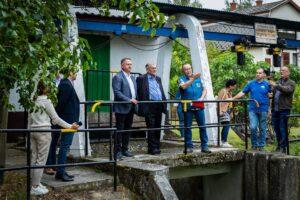Free irrigation water results in cost savings of more than 10 billion forints for farmers
260 locations across the country are being intervened to alleviate water shortages and help reduce the harmful consequences of climate change – the State Secretary for Agriculture of the Ministry of Agriculture announced on Wednesday at the Lakitelek pumping station.

(Photo: AM/Török Levente)
Speaking about the implementation of the water shortage and drought protection action plan, Imre Hubai reported that the available funding of 4.7 billion forints will enable Hungary to “retain as much water as possible in the landscape, to provide as much water as possible for ecological water replenishment, and to fill up spaces suitable for water storage that have been unused for years or decades,” he said. The State Secretary said: The Hungarian government has recognized the problem of water loss caused by the extraordinary drought, which is why irrigation water is free this year as well, which results in cost savings of more than 10 billion forints for farmers. The government has taken on this and is covering it from the central budget instead of the farmers, he added. He recalled that four out of five economic years have been drought years and this year’s drought is as long as the one in 2021-22, so more than 400 millimeters of precipitation are already missing from the Danube-Tisza region and beyond the Tiszántúl. “This is almost a year’s worth of precipitation, and we still don’t know what awaits us,” he said, adding that “we are missing several cubic kilometers of water,” but we are preparing to bring Water to the Landscape! program, the amount of stored water increases by 450-460 thousand cubic meters per day, which currently stands at approximately 178 million cubic meters.
Imre Hubai also spoke about the fact that the number of water shortage management districts involved in the protection has now increased to 55
He highlighted that the Hungarian Tisza watershed is expected to receive approximately 15 to 49 millimeters of precipitation, but according to experts, more than this, even 60 to 100 millimeters, could fall in the Carpathians – he explained, adding that if this arrives, there will be an increase in water resources in the Tisza that will replace the reserves that have not been replenished so far or the reserves that have been drained so far, and can also replace the amount of water arriving at the Lower Tisza, i.e. the section below Kisköre. He reminded that farmers are waiting for their requests for ecological water replenishment to aszalyvedelem@am.gov.hu, and the National Directorate General of Water Management is waiting for the spaces offered for water within the framework of the Water into the Landscape! program, as they are preparing to store approximately 3 billion cubic meters of water, one and a half times the volume of Lake Balaton, next year, i.e. by December 31, 2026, compared to the current 650-660 million cubic meters. So far, they have been able to identify approximately 35 thousand hectares where farmers could absorb the increased water flow during flood waves, he added. The Secretary of State emphasized that within the framework of the drought protection action plan, 38 tertiary canals nationwide were filled, which had not had water for decades, and thus the affected area increased by approximately 54 thousand hectares. Thus, the area of influence on which farmers can irrigate is now 356 thousand hectares nationwide. This could increase the size of irrigated areas by one and a half to two times, he listed.
The majority of lakes have disappeared
Sándor Lezsák, the Vice President of the Parliament and the Fidesz MP for the region, recalled that in the early 1900s there were about 600 lakes in the sand ridge between the Danube and Tisza rivers. Their number decreased to 120 in the 1980s, and then to less than ten in 1995. “Now there are two or three left, whose fate is uncertain if the budget-supported water management program does not appear,” he said. As he said: the Water into the landscape! program, “the government has finally poured clean water into the glass”, because after the bitterness, failure, waiting and tension of the past decades, a decision has finally been made, which has both resources and professional knowledge behind it, and the government’s will and intention to truly revive the sand ridge between the Danube and Tisza.
A coordinated defense is taking place in the entire Tisza Valley
Attila Lovas, director of the Central Tisza Region Water Management Directorate, highlighted: a coordinated defense is taking place in the entire Tisza Valley in a so-called extended Tisza-Körös Valley Cooperative Water Management System. At the same time, experts are optimistic that the amount of water coming from across the border as a result of the precipitation could even fill Lake Tisza to its maximum level, he added. He said about the works carried out at the Lakitelek pumping station: as part of one of the interventions of the drought protection action plan, the sluice in poor condition is being rebuilt, the function of which is to safely retain the water in the canals. Currently, the canal is being temporarily closed and the work area is being drained. After that, the lock will be dismantled and rebuilt from prefabricated elements by the end of August, he explained.
MTI
Related news
AM: Government helps farmers with a loan moratorium
🎧 Hallgasd a cikket: Lejátszás Szünet Folytatás Leállítás Nyelv: Auto…
Read more >More than 100 Hungarian farmers also demonstrated in Brussels
🎧 Hallgasd a cikket: Lejátszás Szünet Folytatás Leállítás Nyelv: Auto…
Read more >NAK: Domestic producers await customers with an ample supply of all pine species
🎧 Hallgasd a cikket: Lejátszás Szünet Folytatás Leállítás Nyelv: Auto…
Read more >Related news
The New Year’s Eve fireworks fair is back: temporary sales will start in department store parking lots at the end of December
🎧 Hallgasd a cikket: Lejátszás Szünet Folytatás Leállítás Nyelv: Auto…
Read more >The first Eastern European non-alcoholic beer turns 50
🎧 Hallgasd a cikket: Lejátszás Szünet Folytatás Leállítás Nyelv: Auto…
Read more >Sausage: pork prices are already going down, but they won’t be cheaper in stores – a significant correction may come in the spring at the earliest
🎧 Hallgasd a cikket: Lejátszás Szünet Folytatás Leállítás Nyelv: Auto…
Read more >






